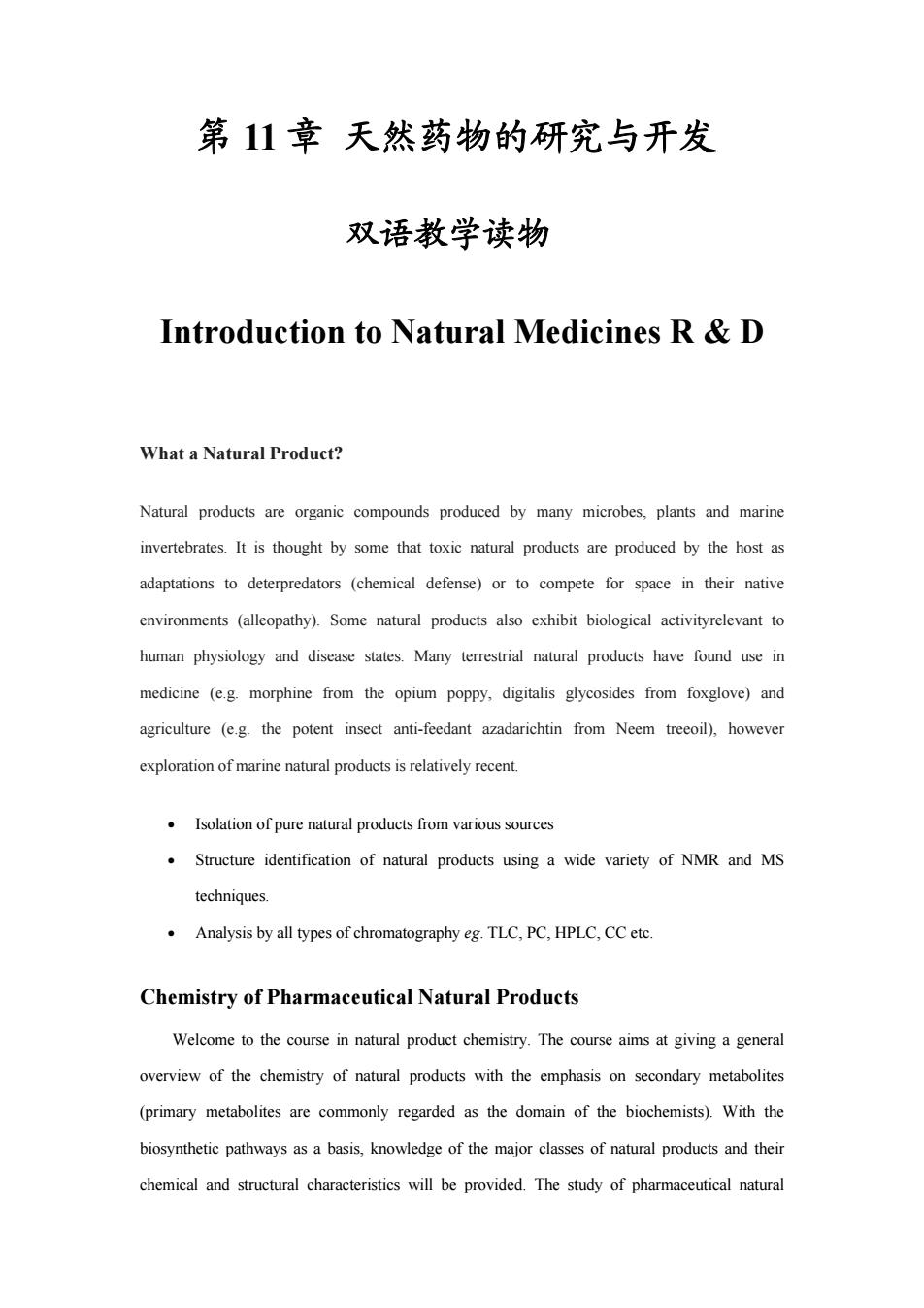
第11章天然药物的研究与开发 双语教学读物 Introduction to Natural Medicines R D What a Natural Product? Natural products are organic compounds produced by many microbes,plants and marine invertebrates.It is thought by some that toxic natural products are produced by the host as adaptations to deterpredators (chemical defense)or to compete for space in their native environments (alleopathy).Some natural products also exhibit biological activityrelevant to human physiology and disease states.Many terrestrial natural products have found use in medicine (gmorphine from the opium poppy,digitalis glycosides from foxglove)and agriculture (e.g.the potent insect anti-feedant azadarichtin from Neem treeoil).however exploration of marine natural products is relatively recent Isolation of pure natural products from various sources .Structure identification of natural products using a wide variety of NMR and MS techniques. Analysis by all types of chromatography eg.TLC.PC.HPLC.CCete. Chemistry of Pharmaceutical Natural Products Welcome to the course in natural product chemistry.The course aims at giving a general overview of the chemistry of natural products with the emphasis on secondary metabolites (primary metabolites are commonly regarded as the domain of the biochemists).With the biosynthetic pathways as a basis,knowledge of the major classes of natural products and their chemical and structural characteristics will be provided.The study of pharmaceutical natural
第 11 章 天然药物的研究与开发 双语教学读物 Introduction to Natural Medicines R & D What a Natural Product? Natural products are organic compounds produced by many microbes, plants and marine invertebrates. It is thought by some that toxic natural products are produced by the host as adaptations to deterpredators (chemical defense) or to compete for space in their native environments (alleopathy). Some natural products also exhibit biological activityrelevant to human physiology and disease states. Many terrestrial natural products have found use in medicine (e.g. morphine from the opium poppy, digitalis glycosides from foxglove) and agriculture (e.g. the potent insect anti-feedant azadarichtin from Neem treeoil), however exploration of marine natural products is relatively recent. · Isolation of pure natural products from various sources · Structure identification of natural products using a wide variety of NMR and MS techniques. · Analysis by all types of chromatography eg. TLC, PC, HPLC, CC etc. Chemistry of Pharmaceutical Natural Products Welcome to the course in natural product chemistry. The course aims at giving a general overview of the chemistry of natural products with the emphasis on secondary metabolites (primary metabolites are commonly regarded as the domain of the biochemists). With the biosynthetic pathways as a basis, knowledge of the major classes of natural products and their chemical and structural characteristics will be provided. The study of pharmaceutical natural
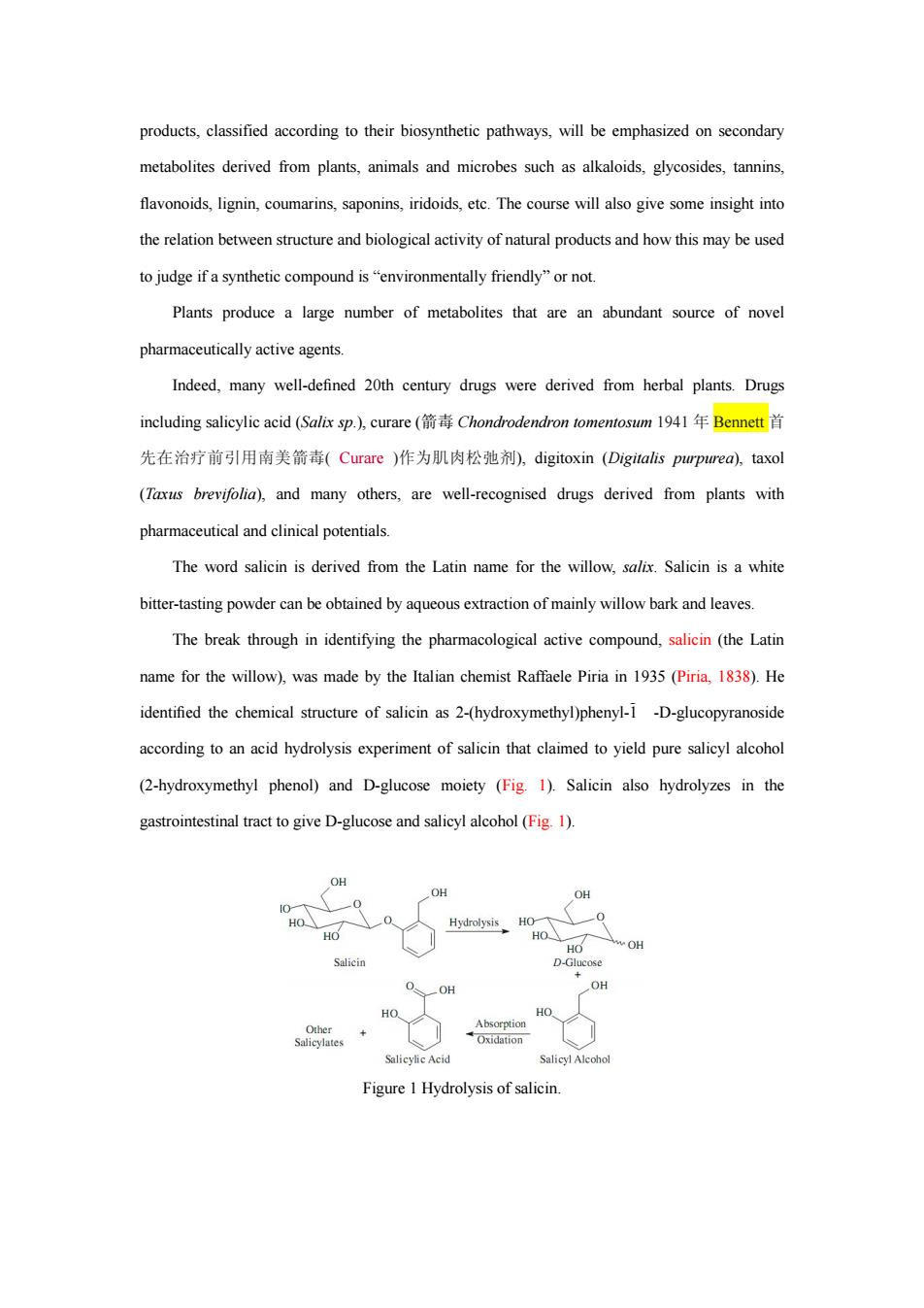
products,classified according to their biosynthetic pathways,will be emphasized on secondary metabolites derived from plants,animals and microbes such as alkaloids,glycosides,tannins, flavonoids,lignin,coumarins,saponins,iridoids,ete.The course will also give some insight into therelation and of natural productsand howthis maybeused to judge if a synthetic compound is"environmentally friendly"or not. Plants produce a large number of metabolites that are an abundant source of novel pharmaceutically active agents. Indeed,many well-defined 20th century drugs were derived from herbal plants.Drugs including salicylic acid(Salix sp.,curare(箭毒Chondrodendron tomentosum194l年Bennett首 先在治疗前引用南美箭毒(Curare)作为肌肉松弛剂,digitoxin(Digitalis purprea),taxol (Txs brevifolia)and many others.are well-recognised drugs derived from plants with pharmaceutical andotenia The word salicin is derived from the Latin name for the willow,salix.Salicin is a white bitter-tasting powder can be obtained by aqueous extraction of mainly willow bark and leaves. The break through in identifying the pharmacologica active(the Latin name for the willow),was made by the Italian chemist Raffaele Piria in 1935(Piria,1838).He identified the chemical structure of salicin as 2-(hydroxymethyl)phenyl-1-D-glucopyranoside according to an acid hydrolysis experiment of salicin that claimed to yield pure salicy alcohol (2-hydroxymethyl phenol)and D-glucose moiety (Fig.1).Salicin also hydrolyzes in the gastrointestinal tract to give D-glucose and salicyl alcohol (Fig 1). OH HO 0 HO Figure I Hydrolysis of salicin
products, classified according to their biosynthetic pathways, will be emphasized on secondary metabolites derived from plants, animals and microbes such as alkaloids, glycosides, tannins, flavonoids, lignin, coumarins, saponins, iridoids, etc. The course will also give some insight into the relation between structure and biological activity of natural products and how this may be used to judge if a synthetic compound is “environmentally friendly” or not. Plants produce a large number of metabolites that are an abundant source of novel pharmaceutically active agents. Indeed, many well-defined 20th century drugs were derived from herbal plants. Drugs including salicylic acid (Salix sp.), curare (箭毒 Chondrodendron tomentosum 1941 年 Bennett 首 先在治疗前引用南美箭毒( Curare )作为肌肉松弛剂), digitoxin (Digitalis purpurea), taxol (Taxus brevifolia), and many others, are well-recognised drugs derived from plants with pharmaceutical and clinical potentials. The word salicin is derived from the Latin name for the willow, salix. Salicin is a white bitter-tasting powder can be obtained by aqueous extraction of mainly willow bark and leaves. The break through in identifying the pharmacological active compound, salicin (the Latin name for the willow), was made by the Italian chemist Raffaele Piria in 1935 (Piria, 1838). He identified the chemical structure of salicin as 2-(hydroxymethyl)phenyl-1 -D-glucopyranoside according to an acid hydrolysis experiment of salicin that claimed to yield pure salicyl alcohol (2-hydroxymethyl phenol) and D-glucose moiety (Fig. 1). Salicin also hydrolyzes in the gastrointestinal tract to give D-glucose and salicyl alcohol (Fig. 1). Figure 1 Hydrolysis of salicin
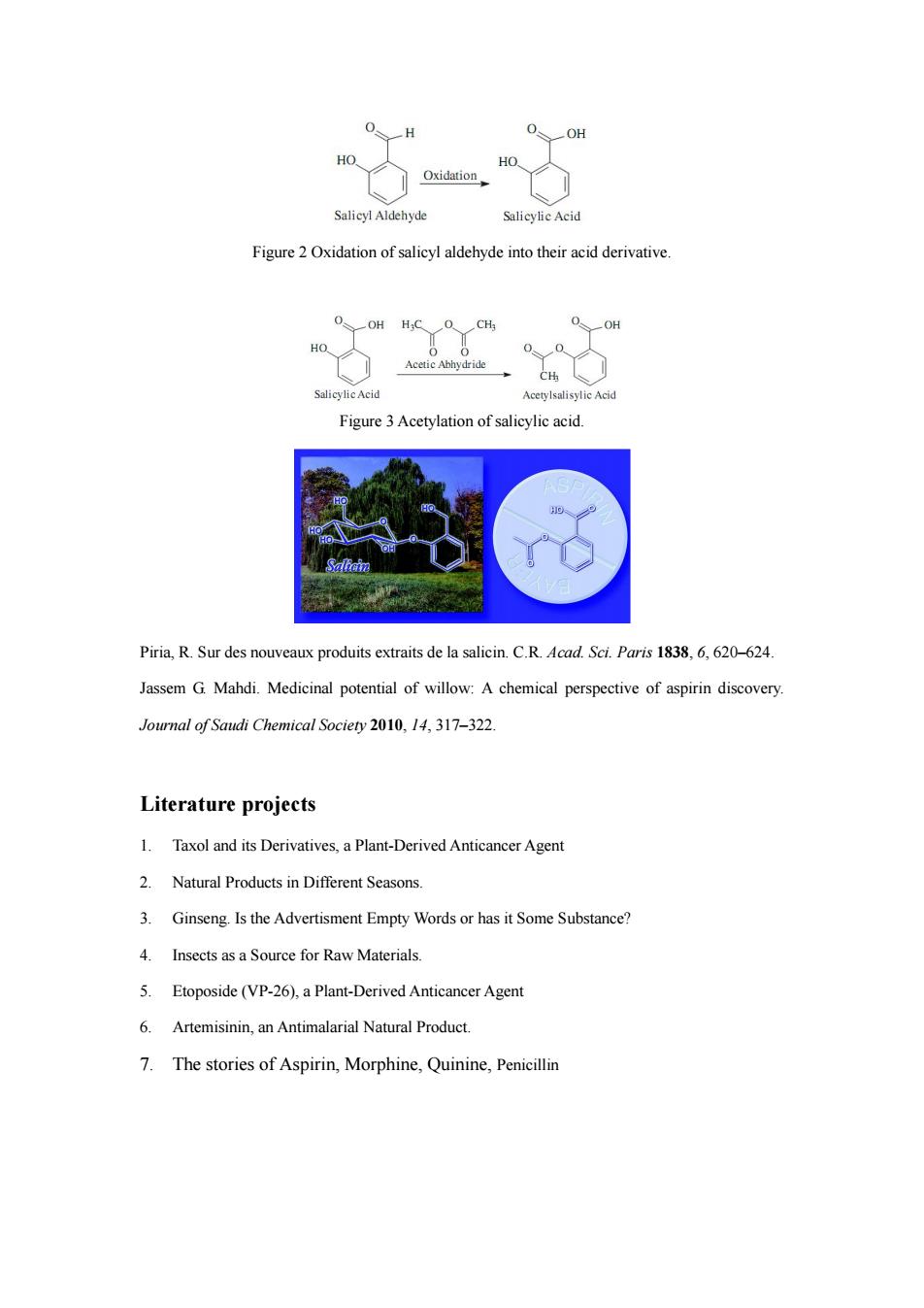
- of salicyl aldehyde into their acid derivative Figure 3 Acetylation of salicylic acid. Piria,R.Sur des nouveaux produits extraits de la salicin.C.R.Acad.Sci.Paris 1838,6,620-624. Jassem G Mahdi.Medicinal potential of willow:A chemical perspective of aspirin discovery. Journal of Saudi Chemical Sociery1.14.317-322. Literature projects 1.Taxol and its Derivatives,a Plant-Derived Anticancer Agent 2.Natural Products in Different Seasons. 3.Ginseng Is the Advertisment Empty Words or has it Some Substance? 4.Insects as a Source for Raw Materials. 5.Etoposide(VP-26),a Plant-Derived Anticancer Agent 6.Artemisinin,an Antimalarial Natural Product. 7.The stories of Aspirin,Morphine,Quinine,Penicillin
Figure 2 Oxidation of salicyl aldehyde into their acid derivative. Figure 3 Acetylation of salicylic acid. Piria, R. Sur des nouveaux produits extraits de la salicin. C.R. Acad. Sci. Paris 1838, 6, 620–624. Jassem G. Mahdi. Medicinal potential of willow: A chemical perspective of aspirin discovery. Journal of Saudi Chemical Society 2010, 14, 317–322. Literature projects 1. Taxol and its Derivatives, a Plant-Derived Anticancer Agent 2. Natural Products in Different Seasons. 3. Ginseng. Is the Advertisment Empty Words or has it Some Substance? 4. Insects as a Source for Raw Materials. 5. Etoposide (VP-26), a Plant-Derived Anticancer Agent 6. Artemisinin, an Antimalarial Natural Product. 7. The stories of Aspirin, Morphine, Quinine, Penicillin
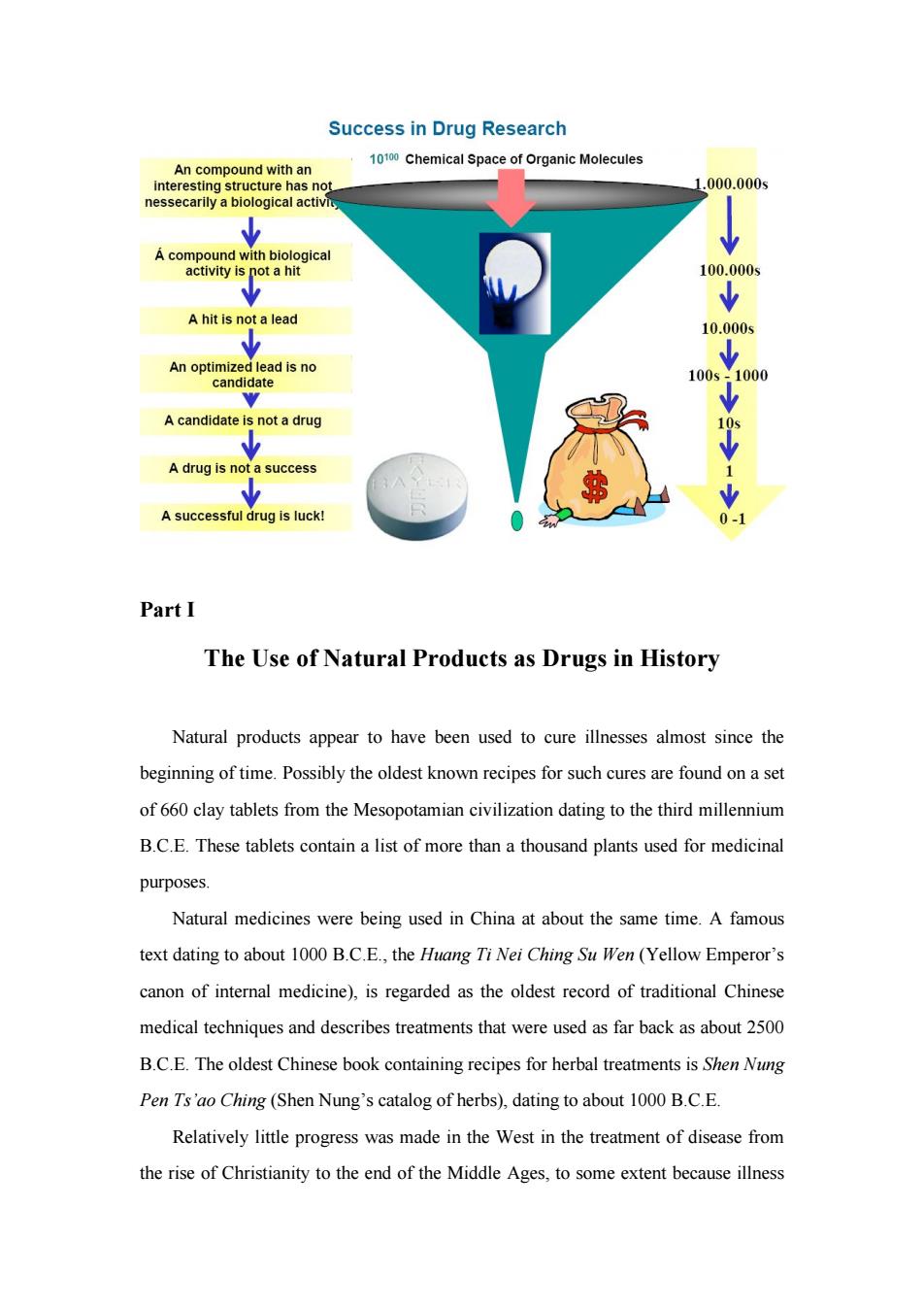
Success in Drug Research An compound with an 10 Chemical Space of Organic Molecules 00 A hit is no a lead ead is no Acandidate not a drug A drug is no success Asuccessful ua is luck PartI The Use of Natural Products as Drugs in History Natural products appear to have been used to cure illnesses almost since the beginning of time.Possibly the oldest known recipes for such cures are found on a set of 660 clay tablets from the Mesopotamian civilization dating to the third millennium B.C.E.These tablets contain a list of more than a thousand plants used for medicinal purposes. Natural medicines were being used in China at about the same time.A famous text dating to about 1000 B.C.E.,the Huang Ti Nei Ching Su Wen (Yellow Emperor's canon of internal medicine),is regarded as the oldest record of traditional Chinese medical techniques and describes treatments that were used as far back as about 2500 B.C.E.The oldest Chinese book containing recipes for herbal treatments is Shen Nung Pen Ts'ao Ching(Shen Nung's catalog of herbs),dating to about 1000 B.C.E. Relatively little progress was made in the West in the treatment of disease from the rise of Christianity to the end of the Middle Ages,to some extent because illness
Part I The Use of Natural Products as Drugs in History Natural products appear to have been used to cure illnesses almost since the beginning of time. Possibly the oldest known recipes for such cures are found on a set of 660 clay tablets from the Mesopotamian civilization dating to the third millennium B.C.E. These tablets contain a list of more than a thousand plants used for medicinal purposes. Natural medicines were being used in China at about the same time. A famous text dating to about 1000 B.C.E., the Huang Ti Nei Ching Su Wen (Yellow Emperor’s canon of internal medicine), is regarded as the oldest record of traditional Chinese medical techniques and describes treatments that were used as far back as about 2500 B.C.E. The oldest Chinese book containing recipes for herbal treatments is Shen Nung Pen Ts’ao Ching (Shen Nung’s catalog of herbs), dating to about 1000 B.C.E. Relatively little progress was made in the West in the treatment of disease from the rise of Christianity to the end of the Middle Ages, to some extent because illness
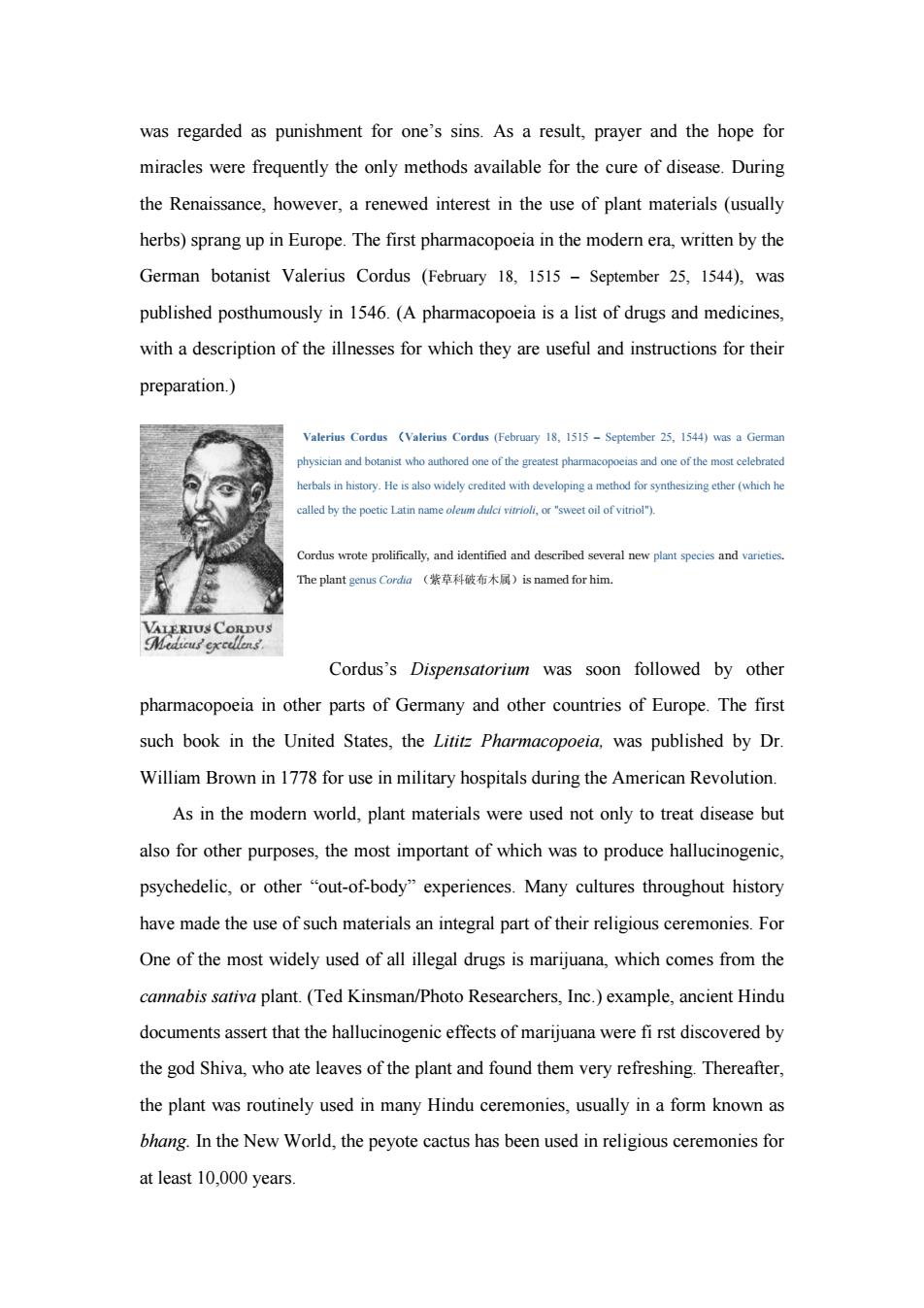
was regarded as punishment for one's sins.As a result,prayer and the hope for miracles were frequently the only methods available for the cure of disease.During the Renaissance,however,a renewed interest in the use of plant materials(usually herbs)sprang up in Europe.The first pharmacopoeia in the modern era,written by the German botanist Valerius Cordus (February 18.1515-September 25.1544),was published posthumously in 1546.(A pharmacopoeia is a list of drugs and medicines. with a description of the ilnesses for which they are useful and instructions for their preparation.) Valerius Cordus (Valeris Cors (Febuary 11515-Seplember 25,154)Gem erhals in history.He is also widely credited with developing a method for synthesizing ether(which h called by the poetic Latin name oleton dlci rimriofi,or "sweet oil of vitriol"). Cordus wrote prolifically,and identified and described several new plant species and vanetes he plant senus Cordia(紫草科破布木属)is named for him. Cordus's Dispensatorium was soon followed by other pharmacopoeia in other parts of Germany and other countries of Europe.The first such book in the United States,the Litit Pharmacopoeia,was published by Dr. William Brown in 1778 for use in military hospitals during the American Revolution. As in the modern world,plant materials were used not only to treat disease but also for other purposes,the most important of which was to produce hallucinogenic, psychedelic,or other"out-of-body"experiences.Many cultures throughout history have made the use of such materials an integral part of their religious ceremonies.For One of the most widely used of all illegal drugs is marijuana,which comes from the camnabis sativa plant.(Ted Kinsman/Photo Researchers,Inc.)example,ancient Hindu documents assert that the hallucinogenic effects of marijuana were fi rst discovered by the god Shiva,who ate leaves of the plant and found them very refreshing.Thereafter. the plant was routinely used in many Hindu ceremonies,usually in a form known as bhang.In the New World,the peyote cactus has been used in religious ceremonies for at least 10,000 years
was regarded as punishment for one’s sins. As a result, prayer and the hope for miracles were frequently the only methods available for the cure of disease. During the Renaissance, however, a renewed interest in the use of plant materials (usually herbs) sprang up in Europe. The first pharmacopoeia in the modern era, written by the German botanist Valerius Cordus (February 18, 1515 – September 25, 1544), was published posthumously in 1546. (A pharmacopoeia is a list of drugs and medicines, with a description of the illnesses for which they are useful and instructions for their preparation.) Valerius Cordus (Valerius Cordus (February 18, 1515 – September 25, 1544) was a German physician and botanist who authored one of the greatest pharmacopoeias and one of the most celebrated herbals in history. He is also widely credited with developing a method for synthesizing ether (which he called by the poetic Latin name oleum dulci vitrioli, or "sweet oil of vitriol"). Cordus wrote prolifically, and identified and described several new plant species and varieties. The plant genus Cordia (紫草科破布木属)is named for him. Cordus’s Dispensatorium was soon followed by other pharmacopoeia in other parts of Germany and other countries of Europe. The first such book in the United States, the Lititz Pharmacopoeia, was published by Dr. William Brown in 1778 for use in military hospitals during the American Revolution. As in the modern world, plant materials were used not only to treat disease but also for other purposes, the most important of which was to produce hallucinogenic, psychedelic, or other “out-of-body” experiences. Many cultures throughout history have made the use of such materials an integral part of their religious ceremonies. For One of the most widely used of all illegal drugs is marijuana, which comes from the cannabis sativa plant. (Ted Kinsman/Photo Researchers, Inc.) example, ancient Hindu documents assert that the hallucinogenic effects of marijuana were fi rst discovered by the god Shiva, who ate leaves of the plant and found them very refreshing. Thereafter, the plant was routinely used in many Hindu ceremonies, usually in a form known as bhang. In the New World, the peyote cactus has been used in religious ceremonies for at least 10,000 years